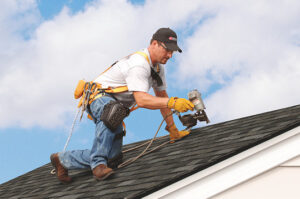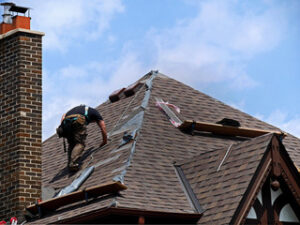A roof protects a building from rain, snow, sunlight, and temperature extremes. It also provides structural support for the wall of the building.
The skeleton of the roof is built from rafters, designed as sloped units using mostly 2x10s or 2x12s extending from your home’s ridge to the exterior walls. For more information visit Roofing Round Rock.

Shingles are one of the most visible parts of your roof and play a significant role in your home’s curb appeal. They’re available in various colors and styles, and your local roofing contractor can help you find the right look for your house. They’ll be familiar with all of the major shingle manufacturers and will know which ones work best in your area.
You can tell if your shingles have been damaged by looking for dark areas on the roof. Some things, including aging, poor installation, or moss and algae, can cause these. Your roofing contractor can remove these areas, or you can clean them with a hose and water.
The most common cause of shingle damage is wind. High winds can cause the granules to make your shingles loose, exposing the asphalt to sunlight and moisture. This can lead to deterioration and leaks.
If you’re concerned about storm damage to your shingles, your roofer can install fasteners with built-in surge protection. These will prevent the shingle’s sealant from being pushed out by wind-driven rain and protect it from future problems.
During a shingles outbreak, you’ll experience pain and itching in a band-like area of your body, typically on the torso or face. You might notice a blistering rash that starts as groups of tiny pimples and then scabs over within 7 to 10 days. Most people get shingles only once, but it can come back in those with weakened immune systems.
In the laboratory, researchers have found that creases in a shingle’s surface can cause it to unbound and lose its strength. The creases can be difficult to see, but a shingle that has lost its strength is likelier to break in a wind storm.
A new shingle with no creases is much more likely to maintain its strength. To prevent shingles from losing their strength, your roofer can install a product like IKO’s FastLock strips on your roof’s eaves and ridge areas.
Roof ventilation is a roofing system’s most important yet under-appreciated aspect. Without it, moisture can build up in your attic and cause rot or mold in your home’s wood framing and walls. It can also make your air conditioning work harder in the summer and cause high energy bills. A well-designed ventilation system can help prevent these problems and extend the life of your roof.
Ventilation allows hot air to escape your attic and cool air to enter in the winter. This can be accomplished by installing intake and exhaust vents in your attic space. Intake vents can be installed in the low area of your attic under the eaves or high on the sides of the roof within a gable or ridge. Exhaust vents can be placed in the soffit or the roof ridge, depending on your attic space.
Generally speaking, building codes recommend 1 square foot of vent area for every 300 square feet of attic floor. This should be split roughly equally between vents high on the roof (within a gable or ridge) and low in the soffit. A professional can assist you in designing the best ventilation for your home or commercial building.
Proper roof ventilation allows warm air to escape the attic during summer and prevents moisture buildup that can damage the shingles and structure of your roof. It can also prevent ice dams during cold weather.
When the roof is not ventilated properly, hot air gets trapped in the attic and can melt snow and ice on the edges of the roof, where it re-freezes. These ice dams can cause significant damage to the roof, attic, and inside the home. In addition, they can lead to leaking, insulation issues, and mold.
When a house is not properly ventilated, the excess heat can cause the shingles to break down and rot prematurely. The resulting mold, mildew, and rotting of the wood in the attic can be a major health hazard to the home’s occupants and may require costly roof repairs or replacement.
Drainage is an important aspect of a roof because it helps to prevent standing water. Water buildup can damage shingles and tiles and cause leaks in the attic or home. Additionally, water accumulation can lead to soil erosion and weaken the house’s foundation. It can also lead to mold and mildew, which are dangerous for human health. A well-designed roof drainage system channels excess water from the roof into ground drains. It also ensures that the water doesn’t damage gutters and downspouts.
Ideally, your roof should have a slope that allows it to flow off easily and prevent pooling. A slight pitch of one to ten degrees is ideal. If you have a flat roof, an internal drain or scupper system is the best way to keep water from collecting on the roof.
Scupper drains are large square openings on the roof that shoot the water down and away from the building. They can be made of plastic, cast iron, or another material. They typically include a cast iron grate to keep debris from blocking the outlet. These are most common on commercial flat roofs.
Inner roof drains are designed to remove water from the building’s interior. They can be used on both flat and low-slope roofs. They are often topped with filters to keep leaves and other debris from blocking them. These are more expensive than different types of drains, but they are highly effective at preventing water from collecting on the roof.
If you find that the water on your roof is still there for more than a day after a rainstorm, it’s time to call in a roofing professional. A blocked drain or gutter may cause the accumulated water. It could also be a sign of structural damage from a recent storm. A roofing professional can check the drainage system and clean out any blockages.
A properly functioning drainage system is critical for the health of your home or business. Water on the roof can rot shingles and tiles, weakening the structure of your home or office. If the drains are clogged, the roof can become unstable and collapse. Clogged gutters can also cause flooding around your property.
The roof is the top part of a building and takes on much of the burden of protecting it from rain, snow, sunlight, wind, and other elements. It must do so because a leaky roof can lead to the house’s interior becoming wet and damaged. Roofs are made from various materials and come in different shapes, depending on the design and style of the building.
Besides protecting the structure from weather, the roof prevents debris from entering a person’s home. When someone chooses to have their roof redone, picking out the right covering is an important decision that they must make. There are several roof covers, and considering energy efficiency is also a good idea. Lighter-colored roof coverings will reflect the sun’s rays, helping to reduce the amount of heat absorbed into the home.
Some of the most common roof coverings are shingles, which can be found in many colors and styles. They are usually composed of a waterproof asphalt base with ceramic granules. Another popular type of roofing is flat roof tiles. These are often made from concrete, clay, or plastic. They can be rolled, glued, or fixed using other methods to form a layer over the underlying surface.
There are other types of roof coverings as well, such as thatch and solar shingles. These tend to be less durable than shingle roofs, but they are very energy efficient. They are also lightweight and easy to install.
Other roof covers include corrugated iron sheets, galvanized steel, and lightweight roofing. These are usually used in rural areas or for industrial buildings. They are easy to install and can be rolled or cut into shapes. The only disadvantage is that they are quite brittle and last only briefly.
When choosing a roof covering, it is important to note that some have strict fire-resistance ratings. For example, a roof that is rated Class “A” must pass the following tests:


